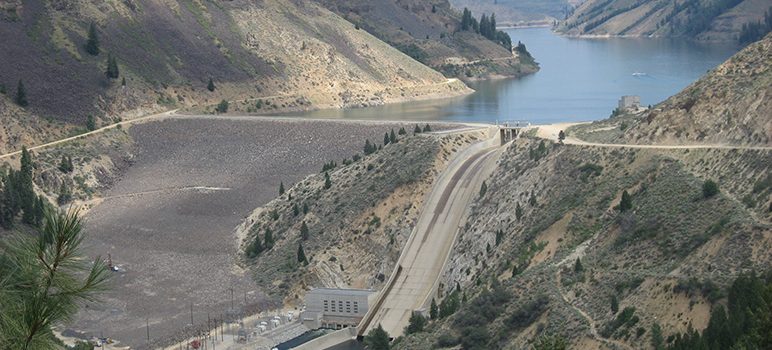Federal engineers have ordered Valley Water to speed up by one year its plans to drain and replace the Anderson Dam in Morgan Hill, citing earthquake dangers.
In a Feb. 20 letter to Valley Water, the Federal Energy Regulatory Commission (FERC) demanded that the district reduce water levels in Santa Clara County’s largest reservoir beginning this spring. The commission ordered the district to begin in October a complete draining of the 1,300-acre reservoir, creating a giant “deadpool” within a year.
The water district had announced last fall that new seismic data prompted it to move up by a year the groundbreaking for a five-year, $550 million project to build a new, earthquake-resistant Anderson Dam, to the summer of 2021. The basin of the popular lake would be empty for at least five years during the dam construction project.
That wasn’t fast enough for engineers with the federal Division of Dam Safety and Inspections. “Until full remediation is completed, the dam safety risk at this project is unacceptably high,” division director David E. Capka wrote in a letter to the district that ordered emptying too begin this year. “Your actions to date do not demonstrate an appropriate sense of urgency regarding the interim conditions at the project.”
The letter followed two months of discussion between the county and the federal agency, and left the local water district scrambling to find money to accelerate plans for the draining—and to find alternative sources of drinking water for Silicon Valley.
Also on Feb. 21, Assemblyman Robert Rivas, whose 20th District includes the Anderson Reservoir, introduced a bill to provide extra state funds and streamline state permits to enable the district to speed up construction of the new Anderson Dam.
The district’s response this week to the new federal demands was conciliatory.
“Valley Water agrees with the Federal Energy Regulatory Commission that is vital we reduce the dam safety risk and move as quickly as possible with the Anderson Dam Seismic Retrofit Project”—the official name of the dam reconstruction—said Valley Water CEO Norma Camacho in a Feb. 24 response to the FERC letter. “Studies have shown a large earthquake could damage Anderson Dam, causing an uncontrolled release of water that could inundate cities and rural areas from San Francisco Bay south to Monterey Bay, including much of Silicon Valley.”
She cautioned that the Anderson dam project “is complicated and time consuming” and noted that the Anderson Reservoir is currently operating below the levels required by federal dam safety officials, at about 68 percent capacity.
The district wrote the federal dam safety division on Jan. 28 that sustaining current water levels in the Anderson reservoir until the construction project begins provides the best balance between earthquake protection, water supply and environmental protection.
The district warned that lowering water levels long before dam construction could actually weaken the 235-foot earthen dam, and increase the potential for landslides from the site that overlooks residential subdivisions in east Morgan Hill.
The district also told the federal engineers that continuing reservoir water levels at a 565-foot elevation (above sea level) adequately protects downstream areas in the event of an earthquake or significant rainfall, maintains existing emergency water supplies in the event of a system outage or drought and maintains water for downstream environmental protection for steelhead, a federally-listed endangered species.
“We do not concur,” the federal dam safety division replied a few weeks later.
“It is unacceptable to maintain the reservoir at an elevation higher than necessary when it can be reduced, thereby decreasing the risk to public safety and the large population downstream of Anderson Dam,” Capka wrote. “Based on this continuing risk to the public, I am directing you to maintain the reservoir no higher than elevation 565 feet, effective immediately.”
The FERC division director also ordered the district to lower reservoir levels by at least another 77 feet, to an elevation of 488 feet before Oct.1 and to “lower the reservoir to deadpool” before the next rainy season.
Capka also told the district to send him within 30 days designs for a new lower-level outlet that would more safely allow the draining of the reservoir into Coyote Creek.
“A priority will be to design and build a large outlet pipe, which will provide greater control over the water levels and increase public safety,” Camacho said in her response to the federal agency this week.
Capka urged the district “to work with all haste to design and secure the necessary permits and complete the design for the larger Anderson Dam Seismic Retrofit Project.”
In January, Valley Water told the federal dam safety division that “the demand to empty Anderson Reservoir could result in unsafe consequences.”
“A top concern is the potential to damage the intake structure, which would give us no way to control water flows out of the reservoir, potentially impacting downstream communities,” the agency stated.
Valley Water also expressed concern about the environmental impacts of these new requirements. “With the draining of the reservoir, experts would expect fish die-offs,” Valley Water officials wrote. “The inability to keep a consistent flow in Coyote Creek downstream of the dam year-round would significantly impact sensitive native fish, amphibians, reptiles, wetlands, and riparian habitats. Water quality could also be significantly impacted downstream of the dam.”
The federal engineers discounted all of these concerns, which they said were secondary to the earthquake dangers, which post a fatal threat if unaddressed.


Two question; When will they lift the daily take limit of fish, and how much are they going to raise the price of water?
By the way that’s not a picture of Anderson Dam!
Or at least not the Anderson Dam in California
https://commons.wikimedia.org/wiki/File:Anderson_Ranch_Dam_and_Reservoir.JPG
SOP for SCVWD, waste tax dollars do nothing and flooding, do nothing and dam gets drained, same with management, waste, friends, million dollar boardrooms, the only pockets getting lined are the board and top staff and there contracting friends., tax payer loses.
SOP for SCVWD do nothing waste tax dollars.